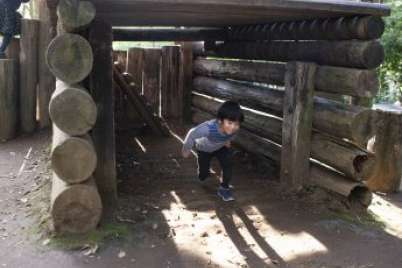
Play centres offer ideas for kids to play their own way
Children are naturally curious about their world and learn through exploration and play. When kids play, they ask questions, test out theories, and solve problems, all while having fun. For many youngsters in early-years programs and kindergarten classes, learning happens at play centres. These themed play areas have a specific focus, such as science, drama, mathematics, or physical activity. Though each centre has a meaningful purpose, each child is free to play their own way with the materials provided.
But play centres aren’t only a great idea in classrooms. You can also make your own play centres at home to continue the learning and the fun, with just a few simple materials. Here are some ideas for ways you can encourage children to move their bodies and explore their world through play.
Science: What do you think might happen next?
This centre is all about curiosity, exploration, and inquiry.
- Nature scientist: Give kids access to tools like a magnifying glass or microscope, thermometer, measuring tape, and binoculars.
- Take a walk outside to collect natural items and bring along a clipboard so kids can record their findings. Encourage observation and prediction-making!
Drama: What else might you need for…?
This centre is all about imagination, storytelling, and empathy.
- Imaginative play: Dress-up clothes, play furniture, and puppets encourage kids to take on different roles, express their emotions, and act out stories.
- Include items that represent the home like kitchen furniture and utensils, as well as other props for children to move in and around.
Related resource: Active for Life activities for kids
Mathematics: How did you find the answer?
Mathematical concepts, strategies, and vocabulary can develop through a variety of learning centres.
- Active math: Game pieces like dominoes, dice, and cards can be used to count and encourage active movements like jumping jacks and basketball dribbles.
- Loose parts play with buttons, bolts, sticks, or other objects incorporate mathematics through sorting and measurement (How big is it? How many are there? How can you divide the objects fairly so you can share?).
Physical activity: Can you move like a (bear, rabbit, crab…)?
Active outdoor play develops gross motor skills essential for children’s physical literacy.
- Water painting: Use a bucket of water and large paint brushes to “paint” bricks, fences, and paths: strengthens muscles with large arm movements, develops self-expression, promotes creativity, and introduces scientific vocabulary like “evaporation.”
- Parachute play: Use a large bedsheet like a parachute and hold the edges to create different movements: requires coordinating and controlling body movements, learning about timing, and develops cooperation and problem-solving skills.
- Ribbon dancing: Tie ribbon to the end of sticks and create different movements: requires controlling movements, experimenting with rhythm, and develops spatial awareness.
- Winter games: Play Follow the Leader in a snow-covered playground: requires balance on different surfaces and exploration of different movements.
- Summer games: Play shadow games on a sunny day (make your shadow tall, make your shadow move quickly, make your shadow jump, etc.): develops problem-solving skills and spatial awareness, enhances vocabulary, and requires controlling movements.
Listening: What do you hear? What does it sound like?
This centre is all about discussing sounds and developing language skills.
- Active listeners: Guide children on a nature walk and give them the tools to record what they hear (audio recorder or clipboard and pencil). You can also try an indoor activity like pairing a printed book with the audio version, or identifying different recorded sounds.
Related read: Executive function is the key to success in school
Art: What do you like about what you did?
This centre is all about children’s interpretations of the world.
- Artists’ toolbox: Kids need access to a variety of materials that encourage experimentation and develop fine motor abilities.
- Painting enhances hand-eye coordination and understanding of colour, shape, and form, while collage develops skills using (safety) scissors and glue.
Water: If I wanted to try what you did, what would I do?
This centre is all about exploring natural elements and connecting them to mathematical and scientific concepts.
- Water play: The bathtub, kitchen sink, or a large bucket all provide opportunities for children to learn about weight, capacity, displacement, and movement in water.
- Consider the following items when preparing a water centre: rocks, marbles, bottles, cups, spoons, funnels, sponges, towels, wands, toy animals, tubing, and water wheels.
Blocks: How does this part work?
This centre is all about children reconstructing and representing the world around them.
- Fort-building: Couch cushions, pillows, and blankets can be perfect building blocks for an indoor fort on a cold day. Planning and moving large household items not only develops gross motor skills, but also teaches kids problem solving concepts.
Related resource: Active for Life lesson plans
Writing: Where did you get the idea for this story?
Writing is an important childhood skill that kids can first learn by developing fine motor skills through pinching and grasping craft materials.
- Providing a variety of writing tools (pencils, pens, markers, crayons, chalk, stamps, stencils, etc.) and writing surfaces (lined paper, coloured paper, index cards, chalkboards, envelopes, etc.) keeps kids interested in learning.
Music: Can you show me how you did that?
This centre is about exploring different rhythms and sounds in music.
- Kids can make homemade instruments using yogurt containers and cans to experiment with different tones, tempos. and beats. Try tapping along to music or making up a song as a family!






Love the ideas – so easy to follow – as a teacher or as a parent/carer or older brother/sister or grandparent.
Play is at the heart of my own work with Tagtiv8 – all about ‘moving & learning’.
Keep up the great work – or should that be play?